While Vancouver Canucks general manager Jim Benning has been busy making improvements to the Canucks’ top-six forward group this summer, it shouldn’t go unnoticed that the bottom-six has seen some healthy additions as well.
It is fully understood that a team’s top two lines are generally responsible for more of a club’s goals, but Vancouver’s management team has done a good job of keeping the third and fourth lines stocked with competitive, gritty players. The Canucks’ deep bottom-six forward group provides head coach Travis Green with numerous possibilities and line combinations.
A Cup Contender Needs It
When you look at teams that regularly contend for the Stanley Cup, or at least make it to the post-season, there are a few things that immediately come into focus: great goaltenders, Norris Trophy-winning defensemen, franchise forwards and in most cases, a deep bottom-six forward group.
A team that finds consistent production throughout the forward lines generally has a much better shot at the prestigious title of ‘Stanley Cup champions.’
In a perfect world, your star player isn’t the only one scoring big goals and keeping your team afloat. Secondary scoring plays a crucial role in competitiveness across the NHL
Former Canucks like Jannik Hansen, Raffi Torres and Manny Malhotra were key pieces in the team’s magical 2010-11 season that placed them in the Stanley Cup Final.
A perennial contender like the Boston Bruins (sorry, Canucks fans) knows all too well the importance of a balanced roster replete with secondary scoring. Despite losing the Cup to the gritty St. Louis Blues last month on home ice, the Bruins once again found goals from their second, third and fourth lines.
Charlie Coyle, who came over from the Minnesota Wild in a trade back in February, was arguably the Bruins’ most effective forward outside of the Bruins top line of Brad Marchand, Patrice Bergeron and David Pastrnak.
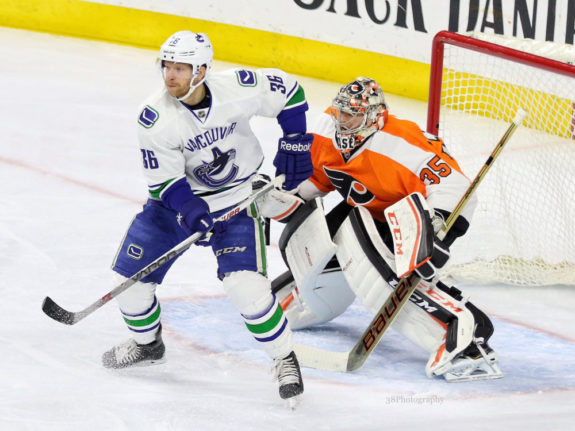
In 24 playoff games, the 6-foot-3, 220 pound Weymouth, MA native scored nine goals and added on seven assists for a respectable 16 points. He was a driving force in the Bruins deep playoff push this season. Winger Marcus Johansson added 11 points in 22 games playing alongside Coyle.
What Do the Canucks Have?
The Canucks boast an absolute myriad of players capable of playing on the third and fourth line in 2019-20. Among the names thrown around, there are a few that stick out and for varying reasons.
The Canucks have made some depth moves this off-season, signing players like 6-foot-4, 214-pound winger Justin Bailey and 6-foot-5, 208-pound center Tyler Graovac, although it is likely that both will start the season with the Canucks’ farm team, the Utica Comets.
Keep in mind, even though many bottom-six depth signings may start out in the AHL when injuries strike – and in Vancouver they always do – these guys will move up to the big leagues to fill holes in the roster.
Josh Leivo, Left Wing
The 6-foot-2, 192 pound Ontario native showed flashes of scoring prowess on a deep Toronto Maple Leafs roster that unfortunately didn’t have the minutes for him. After 27 games in Toronto, the 26-year-old was shipped off to the West coast in exchange for Comet Michael Carcone.
Judging by what we have seen so far, the trade worked out quite well for the Canucks, who saw Leivo put up 10 goals and eight assists for 18 points in 49 games. The hope for next season is that he can play a full 82 games and become an impact player for the team as they look to claw their way back into the playoffs. Leivo finished the season a plus-four for Vancouver. Expect the winger to record around 15 goals and 15 assists in his first full season with the club.
Jake Virtanen, Right Wing
Another player looking to build on a respectable 2018-19 campaign is former first-rounder Jake Virtanen, who set career highs in goals (15) and points (25) in 70 games last season. While the former Calgary Hitmen winger hasn’t necessarily struggled in his young NHL career, he hasn’t quite learned how to use his formidable, 226-pound frame.
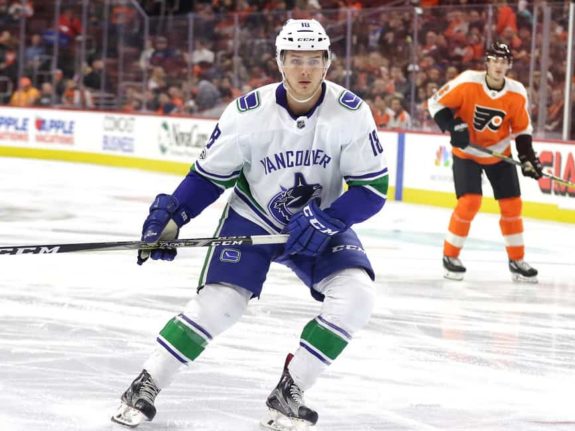
At 6-foot-1, the British Columbia native is getting better every year, but fans still want to see more. On a deeper Canucks team this coming season, it’s reasonable to expect Virtanen to reach 20 goals and 15 assists. What we really need, though, is that physicality the team has lacked in seasons past. Combined with Virtanen’s explosive speed and skating ability, he should be difficult for opposing teams to play against.
Adam Gaudette, Center
The 2018 Hobey Baker award winner seeks to embark on his first full season with the Canucks after splitting his time in the 2018-19 season between Vancouver and Utica. In 56 games at the NHL level, the 22-year-old center contributed five goals and seven assists for a total of 12 points. Going into 2019-20, the Taunton, Massachusetts native is the perfect choice to center the third line behind Elias Pettersson and Bo Horvat.
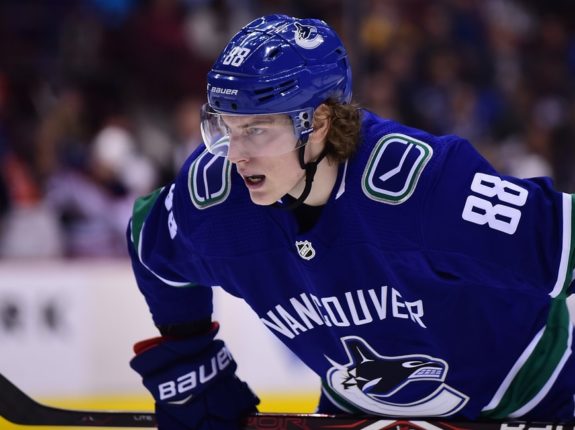
Gaudette is a reliable two-way forward who brings a stellar work ethic and good hockey IQ to a team that greatly struggled with depth over the past few seasons. Expect between 12 and 15 goals from him in his first full season along with 10 assists. Gaudette could potentially move up in the lineup in the case of an injury to a top-six forward.
A ‘Prove It’ Year
In addition to the aforementioned players, the Canucks have several other options to round out the forward lines. While Gaudette, Virtanen and Leivo are almost certainly going to build on their success from last season, there are other players who need to do more. While the lineup in Vancouver has been a revolving door for much of the past two seasons, there are some unproven players who fans still have faith in. Can they step into bigger roles and become difference makers for a team seeking a playoff berth for the first time in five seasons?
Nikolay Goldobin, Right Wing
A name that has been active in the rumour mill for some many months, Nikolay Goldobin will have to settle into a stable role with the Canucks if he wishes to remain in Vancouver.
The 23-year-old Russian native hit career highs in assists and points with 20 and 27, respectively, in 2018-19. He also played 63 games, which is the most he has played since being drafted five years ago. The former Sarnia Sting sniper lit up the OHL in his draft year with 38 goals and 56 assists for 94 points in 67 games.

He was selected in the first round of the 2014 NHL Entry Draft, 27th overall by the San Jose Sharks, with whom he only played 11 NHL games, notching just one goal and one assist. He did, however, excel with the club’s AHL affiliate, the San Jose Barracuda. In 106 career games, he posted 36 goals and 49 assists for a total of 85 points.
Goldobin joined the Canucks in 2017 when he was traded by the Sharks for Hansen. He has done alright in the blue and green, but after posting his highest career point totals in 2018-19, we want to see more.
The young winger would be a perfect fit on the third line alongside Gaudette and Virtanen, a place where he could probably surpass 10 goals and 25 assists in a full season. If he doesn’t impress in the first half of the 2019-20 campaign, he may be moved before the trade deadline.
Reid Boucher, Left Wing
Despite what his NHL point totals would convey, Reid Boucher is still a good hockey player. No, he hasn’t had a breakout season or put up staggering numbers, but he can be effective at the NHL level. Boucher will be 26 in Sep. 2019, and has been great for the Utica Comets, the Canucks’ AHL affiliate, leading the team in goals (56) and points (108) over the past two seasons.
Boucher, when called up to the NHL, has been just fine and gets a passing grade. He had five points in 20 games in 2017-18, which translates to roughly 20 points over a full season, albeit alongside linemates who were not bonafide NHL players.
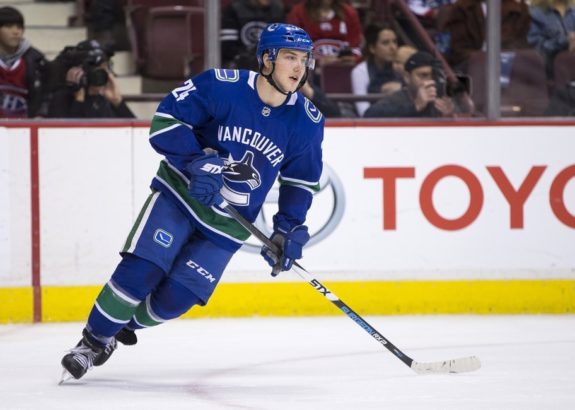
Despite Boucher’s size at 5-foot-10 and 195 pounds, he isn’t afraid to go to those gritty areas and fight for puck possession, which makes him a valuable fourth line type of guy for Green. If he can impress at camp and make the Canucks’ roster, he could be a difference maker for the team next season.
Loui Eriksson, Left Wing
Most fans have been hoping to watch the Loui train leave the station for the better part of three seasons, but with the possibility of a return to Vancouver looming over Benning and Green, the best move might be to use the Swedish veteran as an effective third or fourth liner.
We know his contract is horrendous and it is a task to think of another bottom-six forward making $6 million per year, but if the Canucks can’t move Eriksson by the beginning of the season and he can assert himself as somebody who can still play at the NHL level, it would be best not to completely waste the money.
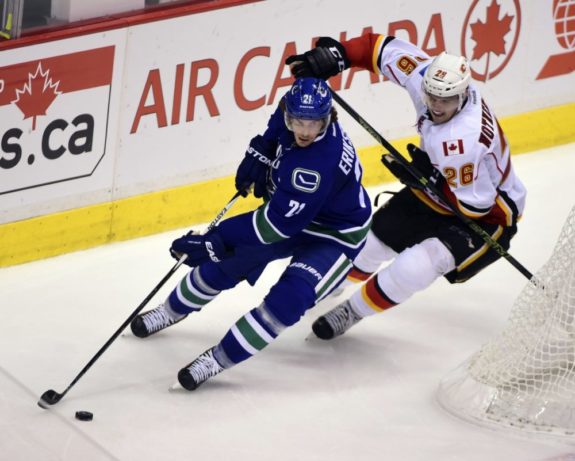
Let him fight for his minutes on the fourth line. Put him on the second power play unit in front of the net. Use him the way the Boston Bruins did. Maybe there is still a way to justify his pay. Even though the former 30-goal scorer is a mere shadow of his former self, he did put up slightly better numbers in 2018-19, tallying 11 goals, 18 assists and 29 points in 81 games.
If the Canucks can find a place for Eriksson on the roster, even if it’s just to do the little things, fans may be able to rest easy and block out the nagging thought of a grossly overpaid fourth liner.
If the idea of Eriksson makes you nauseous, keep in mind that the Canucks still have more options in guys like Tyler Motte and Sven Baertschi, who will likely both make the opening night roster in October. At the very least, find solace in the fact that, for the first time, the Canucks have depth again. Injuries will come, and they may come more often than we would like, but it seems as though this time around the Canucks will be ready.